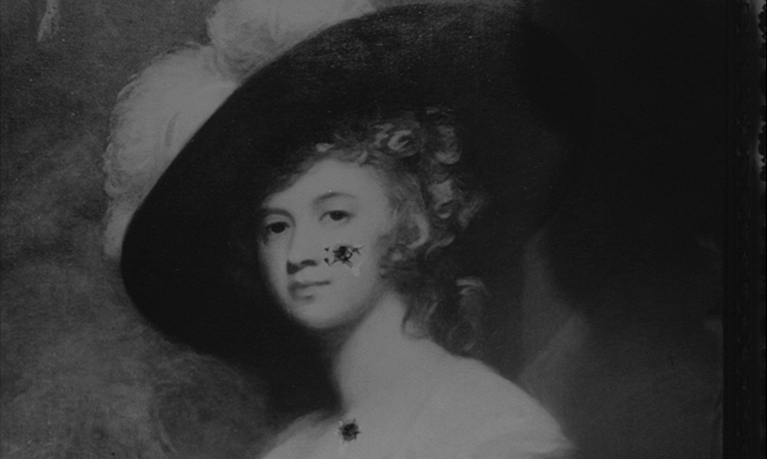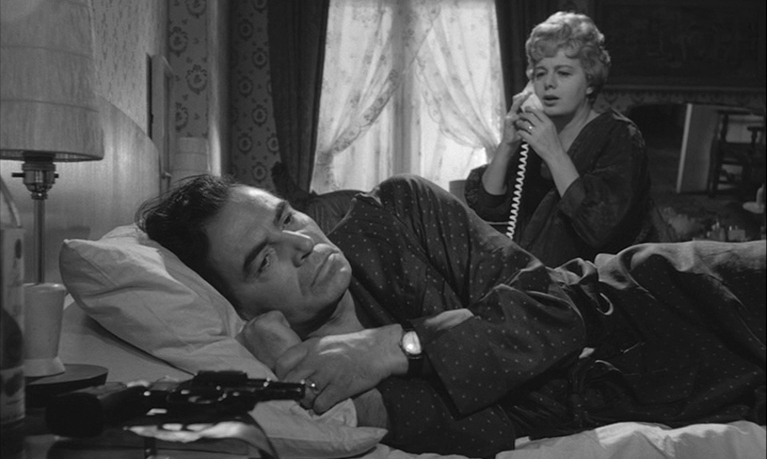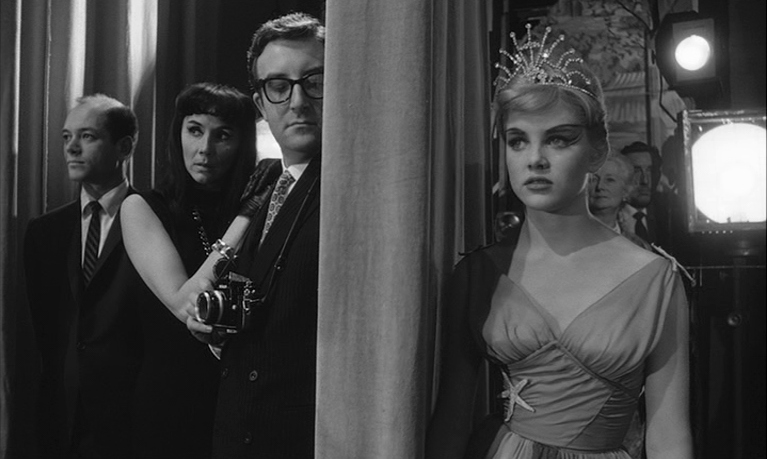Lolita (1962)
After completing his large production epic Spartacus in 1960, Stanley Kubrick and producer James B. Harris took on a giant task in its own right: adapting Vladimir Nabokov’s 1955 novel Lolita. The adaptation would not be an easy one, as the three-hundred-page novel was both complex and controversial, with subject matter that even in a post-Hays Code era wouldn’t be easy to present to a mass audience. Nonetheless, at Kubrick’s behest, Nabokov forged ahead with a 400-page screenplay, MGM financed the production with a $2 million budget, and after some considerable trimming, Kubrick would direct the adaptation released in 1962.
James Mason stars as Humbert Humbert, the film’s bumbling protagonist whose lust and obsession over a teenage girl would drive much of the plot. Sue Lyon was cast as Lolita, the fourteen-year-old girl jockeying for the love of Humbert with her mother Charlotte Haze (Shelley Winter), whose sexual frustrations as a widow motivate her obsessive behavior. To add more spice and chaos to this social drama, Peter Seller was cast as Clare Quilty, an avant-garde playwright whose obsession with Lolita would lead him to impersonate a number of characters to “one-up” Humbert for Lolita’s affection. If this all sounds absurd to you, don’t worry because it truly is. Kubrick decides to show the ending in his first scene, as a determined and scorned Humbert tracks down a drunken and befuddled Quilty. The in medias res opening is a bold move by Kubrick, tipping off the ending to his audience, but he engages them to watch his film looking for the “why” to this violent ending. What better way for Kubrick to tell the story of Lolita, one of failed love and tragic death?
To understand Kubrick’s vision as an auteur, first we most recognize the extreme limitations he faced on this film. Lolita presented a challenge to adaptation, as the novel’s reputation created certain expectations. But neither the narrative perspective nor the subject matter would be so simple to transfer to the screen. In the novel the first-person perspective comes entirely from Humbert, a view that Kubrick would follow loosely in his film. However, the dark desire that Humbert has for a “child-woman” nymphet was simply unacceptable for an early-’60s film audience. In the role of Lolita, Kubrick cast a fourteen-year-old Sue Lyons, who presents a classy and mature teenager whose immature traits come through only in how she relates with the adults in the film. No sexual exploits are shown explicitly, but Kubrick use double entendre and innuendo to make Humbert’s and Lolita’s sexual relationship clear. Some would say Kubrick took much of the “bite” of the novel away and wondered if he made this film a decade too soon. His 1971 film A Clockwork Orange shows no constraint for sex and violence, and perhaps adapting Lolita in the 1970s would have allowed for a less restrained presentation? Regardless, Kubrick’s adaptation works for its own thematic and stylistic reasons.
Lolita isn’t as flashy from a technical standpoint as other Kubrick films, but it’s no less competent from a director approaching the top of his powers. Mise-en-scene is strong and detailed, the only way Kubrick knows how to construct a set and stage a scene. His camera often lingers on his actors, letting the performances do the heavy lifting. His opening scene follows a car through the mysterious fog of a countryside, as a man with a gun enters a trashed mansion looking for revenge. Humbert and Quilty play a game of verbal cat-and-mouse before Humbert symbolically shoots him dead with a shot ending on an 18th-century portrait representing Lolita also being shot through the head.

Idolization of Lolita would drive two grown men mad in the film
Later, visual cues would amplify narrative information. Humbert, Lolita, and Charlotte jockey for hand positions while watching a movie on the couch, just as they lust for each other’s validation. After a quick and demanding marriage to Charlotte (to stay close to Lolita), Humbert starts to make love to her on the bed while starring at a picture of Lolita on the night stand. The gun that Charlotte keeps that belonged to ex-husband is also on the night stand.

Humbert (James Mason) can’t hide his affection for Lolita (Sue Lyon) even when making love to her mother

When tangled in forbidden love, a gun is tied to Humbert’s fate
Kubrick is foreshadowing the future for Charlotte and Humbert. Their faux marriage lacks true love to make it work, and their deception and obsession will lead only to death. Charlotte would soon be killed in the street by a car and Humbert haunted by the many personae of Quilty, who he would eventually kill with Charlotte’s gun. Kubrick is not shy about the Oedipal and Freudian subtexts in Nabokov’s novel: mother and daughter vying for the affection of the “father’: the father favoring the young and naive daughter over the desperate urgings of the mother; the young girl without a father seeking attention and sexual attention from her stepfather and Quilty; and two grown men competing for the “fruits” of a young woman (Humbert tells Charlotte he will stay for the “cherry pie”).

The many faces of Quilty (Peter Sellers) act as destructive force between Humbert and Lolita
Hewing to Humbert’s perspective leaves Quilty’s and Lolita’s moments together offscreen, as the narrow narrative perspective limits Humbert’s–and viewers’–understanding. The bizarre and layered performances Kubrick elicits from Peter Sellers yields perhaps the best element of the film, as Quilty represents a doppleganger of Humbert’s guilt and fear haunting him for much of the film. He also appears as the psychologist Dr. Zempf, a policeman, and photographer, following Humbert and Lolita across the country, driving him insane and stealing Lolita from him at the hospital.
Humbert’s obsession for control of Lolita is challenged by Charlotte, Quilty, high school boys, and Lolita herself. In the end Humbert achieves nothing, his murder of Quilty the only solace he gains from the madness festering inside him. While digging into social satire, Kubrick would unearth the maddening themes about humanity he would soon become obsessed with himself. Further collaboration with Peter Sellers and 1964’s Dr. Strangleove would drop the proverbial bomb on those themes.
Dr. Strangelove or: How I Learned to Stop Worrying and Love the Bomb (1964)
In the early 1960s, Kubrick would find himself obsessed with the nuclear arms race and the anxieties that accompanied the Cold War, reading up to seventy novels on the subject. Catching his eye the most was Peter George’s novel Red Alert, which he purchased the rights to and enlisted the help of Terry Southern to co-write the screenplay. The story entailed accidental nuclear war, and provided much of the character names that would end up in Kubrick’s 1964 political/social satire film, Dr. Strangelove. After many drafts of the screenplay was written and revised, Kubrick felt he needed to execute an accurate portrayal of accidental nuclear war between the USA and Russia, but by adding the tone of absurd black comedy, he would find an immaculate blend of authenticity and entertainment.
The story revolves around three separate U.S. military operations, all being set in motion by each other and yet fairly quickly failing to communicate with one another. General Jack D. Ripper (Sterling Hayden), commander at Burpelson Air Base, orders Group Captain Lionel Mandrake (Peter Sellers) to execute order “Wing Attack Plan R,” an assault with nuclear weapons on Russian targets via the bases B-52 squadron currently two hours from targets. He cites communist infiltration on American soil and the attack on our “precious bodily fluids and essence” as the main influence. He orders his base to lockdown and fire upon anyone trying to break in, even “commies” in American uniforms.

Gen. Jack D. Ripper (Sterling Hayden) orders the wing attack at Burpelson AB
This action puts one B-52 from the base on high alert, lead by pilot Major “King” Kong (Slim Pickens) as they fear the worst back in their home country and plan to bomb their target in Russia. Finally, the “war room” of the highest government officials tries to avert the potential global disaster. President Merkin Muffley (Peter Sellers), General “Buck” Turgidson (George C. Scott), and Dr. Strangelove (Peter Sellers) deliberate the options of potential disaster should the American planes reach a target and set off the nuclear deterrent “doomsday machine” created by the Soviets.
Dr. Strangelove would be Kubrick’s first major film where he would have complete control in all aspects–producing, co-writing, and directing. While choosing to intertwine three narrative actions all occurring simultaneously, the results all have an effect on each other. Kubrick and his crew re-created the look of an American B-52 from a photos of a British trade magazine. Interior shots of the plane sequences are all filmed tightly, with medium close-ups, close-ups, and extreme close-ups trapping the viewer in with the crew on their mission. Accompanying the shots are the only musical score used in the film between the opening and closing credits, an instrumental version of the Civil War plaint When Johnny Comes Marching Home. A ten-foot-long version of the plane “miniature” filmed over a projection matte of a frozen tundra provide the exterior shots of the plane.

Maj. Kong (Slim Pickens) wears his cowboy hat in the B-52 cockpit
The B-52 set piece contrasts the other two sets involving Burpelson Air Base and the “War Room.” General Ripper spends his entire time during the film in his office, eventually accompanied by Captain Mandrake as he desperately tries to avert the attack he has ordained. During their intense conversation over the “why” of Rippers surprise actions, Kubrick stages one of his most iconic close-ups, with General Ripper smoking a cigar (more on this later) at a low angle. Kubrick’s choice to use black-and-white cinematography for the final time in his career was greatly rewarded in this scene.

An iconic low-angle close-up of Gen. Ripper explaining his madness
Kubricks “War Room” is one of the best sets he’d ever construct, a cave-like dungeon for the top American officials to deliberate. Lights shine only from the side wall and above the round table that they all sit around, not unlike grown men sitting around a poker table with countries and human lives being the stakes. The “Big Board” illuminates Russia and the United States, showing aircraft in the air on a minute-by-minute update. Conversations are typically filmed from the center of the table directly at the speaker, or voyeuristically between two officials as they gaze upon the speaker.

The War Room as designed by Kubrick and his crew
Thematically speaking, this film would be Kubrick’s richest to date, and perhaps of his entire career. He hammers home his obsession with love and violence, this time in the form of sexual and military aggression. General Ripper explains to Captain Mandrake that he first felt a loss of essence when being intimate with a woman. He claimed that women could sense his power and take it through his bodily fluids, a plot that he also ties to the “Commies.” He takes matter into his own hands by bombing them to protect his own ideals. When Kubrick first introduces Major Kong on the B-52, he dollies his camera back to reveal him looking at a Playboy magazine. The woman he is looking at is Miss Scott (Tracy Reed), who in the next scene is shown at the hotel of General Turgidson, who promises to return to her after the meeting in the “war room” before she can say “BLAST OFF!”

Miss Scott (Tracy Reed) acts as secretary for the sexually charged and war craved Gen. Turgidson
Kubrick and George C. Scott characterize Buck as a man whose sex drive and lust for war with the “Russkies” as an urge all in the same. Near the end of the film, Major Kong manual releases the bomb, riding it down to the target like a cowboy atop his giant phallic device.

Maj. Kong rides the bomb down to its target like a rodeo bull
Kubrick opens the film with aircrafts being refueled by in-flight re-fuelers, imagery clear with sexual connotations. Dr. Strangelove arouses the high government officials in the room with the idea of storing colonies of Americans in mine shafts during nuclear fallout, and assigning women of stimulating sexual attributes to the men, and ten women to each man. Kubrick can’t help being critical of man’s apparently insatiable lust for sex and destruction.
Dr. Strangelove would be the pinnacle of Kubrick’s work to this point in his career. An auteur at the top of his craft and executing a singular vision, Kubrick would make a political and social satire unlike any other at the time. While bringing to surface such a grim and disturbing topic like nuclear war, Kubrick mixes it with the only ingredient that could make the human race re-evaluate its severity: humor. Reverting back to the criteria for “auteur” that Andrew Sarris proposed, we see a clear and distinct style from Kubrick in his first 10 years of work. From Killer’s Kiss to Dr. Stangelove, he always has a strong grasp on shot composition and framing with his cinematography. His control over every detail of design and production value solidifies a singular vision throughout his work thus far, tackling themes of love, sex, violence, death, and flawed character traits of humanity. As an established director without studio interference, he was beginning to push the envelope as American cinema was about to allow for new auteurs to emerge. Kubrick was not finished exploring bold new horizons, a feat he would accomplish with his next film, 2001: A Space Odyssey.

Recent Comments